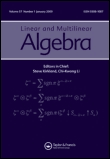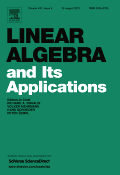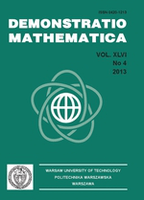
Operators and Matrices
Scope & Guideline
Charting New Territories in Operators and Matrices Research
Introduction
Aims and Scopes
- Operator Theory:
The journal publishes research on various types of operators, including bounded, unbounded, linear, and nonlinear operators, exploring their properties, spectra, and functional relationships. - Matrix Analysis:
It covers the study of matrices, their structures, types, and the relationships between different classes of matrices, particularly in terms of numerical ranges, spectra, and inequalities. - Functional Analysis Applications:
Papers often discuss the applications of operators and matrices in functional analysis, including the study of Hilbert spaces, Banach spaces, and their related algebraic structures. - Inequalities and Numerical Ranges:
A significant focus is on inequalities related to operators and matrices, particularly numerical radius inequalities, which are essential in understanding the behavior of linear transformations. - Perturbation Theory:
Research often addresses perturbations of operators and matrices, studying stability and changes in spectral properties under various perturbations. - Graph Theory and Operators:
The journal also explores connections between operator theory and graph theory, particularly in spectral analysis related to graph structures.
Trending and Emerging
- Advanced Spectral Theory:
There is a noticeable increase in research related to advanced spectral theory, particularly concerning the spectral properties of complex and infinite-dimensional operators. - Operator Algebras and Noncommutative Geometry:
Emerging interest in operator algebras and their applications in noncommutative geometry is evident, reflecting a broader trend in modern mathematical research. - Stability Analysis and Control Theory:
The journal is increasingly publishing work on stability analysis of operators and matrices in control theory contexts, indicating a crossover between pure and applied mathematics. - Numerical Methods and Computational Techniques:
An upsurge in studies focusing on numerical methods for operator equations and matrix computations signals a growing emphasis on computational approaches in the field. - Graph-Theoretic Approaches to Operators:
Research integrating graph theory with operator theory is gaining traction, highlighting the interdisciplinary nature of current mathematical explorations.
Declining or Waning
- Classical Operator Theory:
There seems to be a waning interest in classical operator theory topics that do not incorporate modern techniques or applications, as newer methodologies are being favored. - Basic Matrix Algebra:
The focus on fundamental matrix algebra topics appears to be declining, with more emphasis now on advanced applications and theoretical implications rather than basic properties. - Elementary Inequalities:
While inequalities remain a core interest, simpler or more classical inequalities are being overshadowed by more complex, nuanced results that involve advanced operator techniques. - Determinantal Inequalities:
Research centered around basic determinants and their inequalities seems to be less frequent, as the field moves towards more sophisticated applications in higher-dimensional contexts. - Single-variable Operator Problems:
Problems involving single-variable operators are becoming less prevalent, with a trend towards multi-variable and more complex operator interactions.
Similar Journals

Advances in Operator Theory
Illuminating Complexities in Operator TheoryAdvances in Operator Theory is a premier journal dedicated to the exploration of innovative and foundational research within the disciplines of Algebra and Number Theory, as well as Analysis. Published by SPRINGER BASEL AG, this journal provides a vital platform for the dissemination of high-quality research and theoretical advancements in the realm of operator theory. With a commendable impact factor and categorized in the Q3 quartile for both Algebra and Number Theory and Analysis in 2023, it holds significant standing in the Scopus rankings, substantiating its relevance in the mathematical community. The journal encourages open discussions and lively exchange of ideas among researchers, professionals, and students alike, fostering an environment conducive to scholarly growth and collaboration. Based in Iran at PICASSOPLATZ 4, BASEL 4052, SWITZERLAND, it has been actively publishing since 2016, making substantial contributions to its field through rigorous peer-reviewed articles. As an essential resource for anyone invested in the forefront of mathematical research, Advances in Operator Theory continues to illuminate complex topics and inspire future inquiries.

Complex Analysis and Operator Theory
Bridging Theory and Practice in Operator AnalysisComplex Analysis and Operator Theory, published by Springer Basel AG, is a renowned journal in the field of applied and computational mathematics, reflecting a strong engagement with contemporary mathematical challenges. With an ISSN of 1661-8254 and E-ISSN 1661-8262, this journal provides a platform for disseminating significant findings and innovative methodologies that contribute to the advancement of complex analysis, operator theory, and their diverse applications. As a valuable resource for researchers and practitioners alike, it features high-quality peer-reviewed articles that rigorously explore both theoretical and practical aspects of mathematics. Although it currently does not offer open access, readers can access its insightful content through institutional subscriptions or individual purchases. Since its inception in 2007, the journal has carved a niche for itself, evidenced by its placement in the Q2 quartiles in both Applied Mathematics and Computational Mathematics, and its recognition in Computational Theory and Mathematics. With an ambitious goal to foster the dialogue between theory and practice, Complex Analysis and Operator Theory continues to support the mathematical community from its base in Basel, Switzerland.

LINEAR & MULTILINEAR ALGEBRA
Pioneering Insights into Linear and Multilinear StructuresLINEAR & MULTILINEAR ALGEBRA, published by Taylor & Francis Ltd, is a distinguished academic journal that has been contributing to the field of mathematics since 1973. With an ISSN of 0308-1087 and an E-ISSN of 1563-5139, this journal focuses on innovative research in algebra and number theory, reinforcing its standing as a vital resource for mathematicians worldwide. Currently ranked in the Q2 quartile of its category, and holding an impressive rank of 13 out of 119 in Scopus, it occupies a prominent position in the field, commanding a significant 89th percentile. The journal aims to disseminate groundbreaking research, critical reviews, and theoretical advancements, making it an essential platform for both established researchers and emerging scholars. With a publishing horizon stretching to 2024, LINEAR & MULTILINEAR ALGEBRA is poised to continually influence the mathematical community while fostering a deeper understanding of linear and multilinear frameworks.

Computational Methods and Function Theory
Fostering collaboration through rigorous mathematical exploration.Computational Methods and Function Theory is a distinguished journal published by SPRINGER HEIDELBERG, dedicated to advancing the fields of computational mathematics and functional analysis. With its ISSN 1617-9447 and E-ISSN 2195-3724, this journal serves as a vital resource for researchers, professionals, and students seeking to explore state-of-the-art methodologies and theoretical developments from 2011 to 2024. Its robust ranking positions it in the Q3 category for Analysis and Computational Theory and Mathematics, and Q2 for Applied Mathematics, reflecting the journal's influence and credibility within the scientific community. Residing in Germany, the journal promotes open dialogue and innovative solutions to complex mathematical problems, making significant contributions to both theoretical and applied disciplines. Its impact is evidenced by strong Scopus rankings, asserting its relevance and rigorous peer-review processes, which ensure high-quality publications. This journal stands as a key platform for disseminating groundbreaking research and fostering collaboration across disciplines.

ACTA SCIENTIARUM MATHEMATICARUM
Exploring Innovative Solutions in Mathematical AnalysisACTA SCIENTIARUM MATHEMATICARUM, published by SPRINGER BIRKHAUSER in Switzerland, is a distinguished journal focusing on the fields of mathematical analysis and applied mathematics. With an ISSN of 0001-6969 and an E-ISSN of 2064-8316, this journal serves as a critical platform for disseminating high-quality research that bridges theoretical and practical aspects of mathematics. Although currently categorized in the Q3 quartile for both Analysis and Applied Mathematics as of 2023, the journal strives to enhance its impact on the mathematical community by offering a perfect blend of rigorous research and innovative applications. Researchers, professionals, and students can benefit from the journal’s commitment to advancing knowledge in mathematics, despite the absence of open-access options. The mailing address for correspondences is 233 SPRING STREET, 6TH FLOOR, NEW YORK, NY 10013. As mathematics continues to evolve, ACTA SCIENTIARUM MATHEMATICARUM positions itself as a valuable resource for those looking to contribute to and stay informed about the latest developments in this vibrant field.

LINEAR ALGEBRA AND ITS APPLICATIONS
Elevating Mathematical Understanding Through Rigorous ScholarshipLINEAR ALGEBRA AND ITS APPLICATIONS, published by Elsevier Science Inc, is a prestigious journal that serves as a vital resource in the field of mathematics, specifically focusing on the areas of linear algebra and its myriad applications across various disciplines. Since its inception in 1968, this journal has established a solid reputation, achieving an impressive impact factor that places it in the Q1 category for Algebra and Number Theory as well as for Discrete Mathematics and Combinatorics in 2023, showcasing its significant contribution to these fields. The journal's rigorous peer-review process ensures that published works reflect the highest standards of scholarly research, further establishing it as a leading publication for mathematicians and researchers alike. Although it does not currently offer Open Access options, its wide-reaching audience can access invaluable findings and innovations within its pages. With a commitment to advancing knowledge and fostering innovation, LINEAR ALGEBRA AND ITS APPLICATIONS continues to be an essential platform for disseminating impactful research that shapes the future of mathematics.

Rendiconti del Circolo Matematico di Palermo
Cultivating Mathematical Excellence Since 1887.Rendiconti del Circolo Matematico di Palermo, published by SPRINGER-VERLAG ITALIA SRL, is a revered journal in the field of mathematics, emphasizing the cultivation and dissemination of mathematical knowledge since its inception in 1887. With its ISSN 0009-725X and E-ISSN 1973-4409, this esteemed publication has continued to thrive, showcasing innovative research, comprehensive reviews, and thoughtful discussions from diverse areas in mathematics, particularly in its Q2 ranking within the miscellaneous mathematics category. Its historical significance is underscored by its convergence of publications across numerous years, including its notable periods from 1887 to 1916, 1919 to 1938, and beyond, effectively capturing the evolution of mathematical thought. Though not open access, the journal remains an essential resource for researchers, professionals, and students aiming to stay updated with the latest advancements and methodologies in the ever-evolving landscape of mathematics. With its Scopus rank placing it in the top 25th percentile, Rendiconti del Circolo Matematico di Palermo continues to be a cornerstone for scholarly dialogue and development in its domain.

Annales Fennici Mathematici
Advancing Mathematical FrontiersAnnales Fennici Mathematici is a prestigious academic journal published by Suomalainen Tiedeakatemia based in Helsinki, Finland. With an ISSN of 2737-0690 and an E-ISSN of 2737-114X, this journal has quickly established itself as an essential resource in the field of mathematics since its inception in 2021. It boasts an impressive Q1 categorization in Mathematics (miscellaneous) for 2023, highlighting its impact among top-tier mathematical publications. Currently, it holds a Scopus rank of #135 out of 399 in General Mathematics, placing it in the 66th percentile among its peers, ensuring visibility and relevance for its published works. The journal is committed to providing a platform for innovative research and the dissemination of mathematical discoveries, making it an invaluable resource for researchers, professionals, and students looking to expand their knowledge and engage with contemporary mathematical challenges.

Demonstratio Mathematica
Championing Open Access in Mathematical ResearchDemonstratio Mathematica, published by DE GRUYTER POLAND SP Z O O, is an esteemed open-access journal in the field of mathematics, with an ISSN of 0420-1213 and E-ISSN 2391-4661. Established in 1996 and providing open access since 2009, it has become a vital platform for disseminating innovative research and advancements in various areas of mathematics. With a commendable Scopus ranking of 85/399 in General Mathematics and a 2023 Category Quartile of Q2, it stands at the forefront of the mathematical community, demonstrating a significant impact within the top 78th percentile. The journal aims to foster a deeper understanding and appreciation of mathematical concepts and their applications, catering to both seasoned researchers and emerging scholars. Located in Warsaw, Poland, Demonstratio Mathematica not only enriches the academic discourse but also strengthens collaborative efforts within the international mathematics community, making it an essential resource for those seeking to expand their knowledge and research output.

Commentationes Mathematicae Universitatis Carolinae
Advancing Knowledge in Mathematics Since 1996Commentationes Mathematicae Universitatis Carolinae, with ISSN 0010-2628 and E-ISSN 1213-7243, is a distinguished academic journal published by the Faculty of Mathematics and Physics at Charles University in the Czech Republic. Established in 1996, this journal serves as a platform for original research articles and contributions in the field of mathematics, catering to a diverse range of topics within the discipline. While classified in the Q4 quartile for 2023, it occupies an important niche within the mathematical community, particularly for emerging research and comprehensive studies. Although it is not open access, it offers authors an opportunity to disseminate their work through a reputable publisher, renowned for its scholarly contributions. With a focus on fostering academic discourse, Commentationes Mathematicae aims to engage researchers, professionals, and students alike, enriching the mathematical landscape and promoting collaboration within the field.